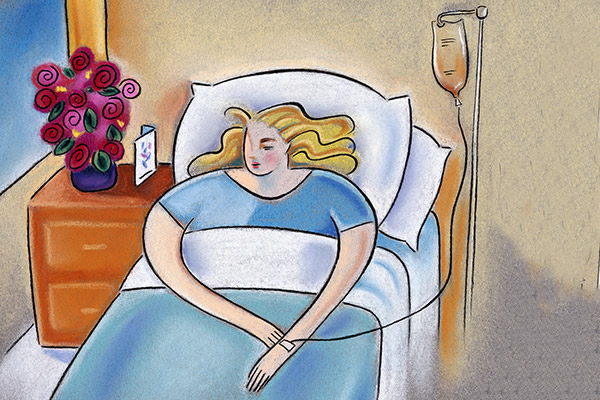Music therapy improves symptoms and behaviors of palliative care patients
by Erin M. Burns, PhD, MSPH
Music therapy interventions have led to improved outcomes for patients with a number of common conditions. The effects of patient characteristics, goals, and interventions on outcomes aren’t fully understood, however. A recent study was designed to get some answers.
Does music truly have the power to heal? A recent study, published in American Journal of Hospice and Palliative Medicine, suggests that it does. According to the authors, music therapy improves a host of symptoms, including pain, anxiety, depression, and shortness of breath, among others.1
Music therapy, an evidence-based practice, involves addressing patients’ individualized goals through a therapeutic relationship with a board-certified music therapist (MT-BC),2 who can help patients address their physical, social, emotional, psychological, and spiritual needs.3 Interventions include playing instruments, listening to music, choosing songs, singing, songwriting, music-assisted relaxation/imagery, and improvisation.
Previous studies have reported improved outcomes with music therapy; however, the effects of patient goals, patient characteristics, and music therapist interventions haven’t been investigated in-depth.
Research that strikes a chord
“Our study looks more in-depth at music therapy interventions and their effects on symptoms,” explains Lisa M. Gallagher, MT-BC, of the Cleveland Clinic Arts & Medicine Institute, in Lyndhurst, Ohio. “We also had the opportunity to utilize a database of over 1500 patient records and were able to obtain statistically significant results with the largest number of patients researched to date—293 who met all study inclusion criteria.”
The objectives of the study included the following:
- To describe patient characteristics, patient goals, and interventions used by the music therapist
- To assess the impact of music therapy sessions on outcomes
- To identify which patient characteristics, goals, and interventions had an effect on outcomes
This retrospective study included data obtained from music therapy sessions held between September 2000 and May 2012. “Sessions were conducted with patients and any family members present,” Gallagher says. “These included addressing any symptoms such as pain, anxiety, depression, shortness of breath, and mood, while also working on other goals, such as coping and relaxation. We had patients rate the level of their symptoms before and after the sessions, and we were able to investigate the level of change that occurred.” Moreover, therapists examined changes in vocalization, facial expression, and body movement.
Interventions were classified according to 6 main categories, including music-assisted relaxation, music listening, verbal/emotional participation (verbal processing, lyric analysis, etc.), verbal/cognitive participation (music discussion, songwriting, etc.), vocal participation (singing and humming), and physical participation (clapping, foot-tapping, playing instruments). In the majority of the sessions, the MT-BC used more than 1 intervention.
The database included 5970 music therapy sessions spread among 1570 patients who were at least 18 years old and reported a minimum of 1 incidence of depression, anxiety, mood, pain, or shortness of breath before and after their session. For patients who participated in more than 1 session, only data from the first session was included.
What the study revealed
The final analysis included 293 patients with complete data on all primary outcome measures. Of these patients, most (67%) were women, with a median age of 61 years and a cancer diagnosis (93%). Lung cancer, hematologic cancers, breast cancer, and gastrointestinal cancer were the most common. The most frequent reasons for referral to music therapy were enjoyment (23%); relief of anxiety (16%), pain (13%), or depression (12%); and support (7%).
Significant improvements in the mean scores from pre- to post-session were reported for pain, depression, anxiety, shortness of breath, mood, facial expression, and vocalization. No significant improvement was reported for body movement. Positive verbal responses were recorded for 96% of patients; 4% had ambivalent responses or no response. (Demographics and cancer diagnosis did not impact outcomes.)
“We found that vocal and emotional interventions were the two most effective interventions for improving symptoms,” Gallagher says. “Perhaps the only surprise was the level of response—for instance, that 96% had a positive response to their experience and that both clinical and statistical significance were demonstrated.”
Ending on a high note
In this study, the greatest percentage of patients achieved clinically relevant improvements in mood, vocalization, and facial expression. These results also demonstrate that, going forward, no intervention changes are required based on age, gender, or diagnosis.
Limitations of the study included the use of observational behavioral data and the potential for reporting bias. Furthermore, data were missing for patients who experienced severe pain or high anxiety, had fallen asleep, were actively dying, or participated in sessions that were interrupted.
“There are a few other questions that we would like to investigate,” says Gallagher. “These include the cost-effectiveness and duration of music therapy; the validation of scales for mood, anxiety, and depression; and a more in-depth look at specific interventions used to address goals with patients and families.”
“I knew at a gut level that music therapy was effective,” Gallagher continues, adding that the current study helped to demonstrate that. Music therapy is an evidence-based profession that provides value-based healthcare to a wide variety of patients, including palliative medicine patients.”
Published: March 01, 2018
References
- 1. Gallagher LM, Lagman R, Rybicki L. Outcomes of music therapy interventions on symptom management in palliative medicine patients. Am J Hosp Palliat Care. 2018;35:250-257.
- 2. American Music Therapy Association. What is music therapy?
- 3. Nightingale CL, Cranley NM, Kacel EL, et al. Music interventions during end-of-life care. OA Alternative Medicine. 2014;2:7-14.
